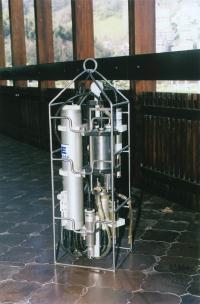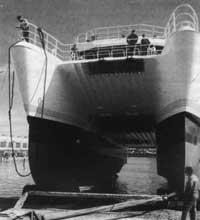Sea Scent Witnesses
2000/05/02 Roa Zubia, Guillermo - Elhuyar Zientzia
The venue is located opposite the beach of Ondarreta and facing the sea. It cannot be otherwise. The large team of scientists from different fields analyses the sea from different points of view. The studies are divided into five major areas.

The first is “environmental observation”. Analyzes the quality control of the marine environment. Global monitoring projects based on periodic sampling as well as actions on specific issues. The other area analyzed is the “coastal dynamics”. It provides an analysis of the processes that take place in nature on the coast. For example, mixtures of water masses, drawers, winds, fast water, bathymetry, sediment transport, etc. are investigated. The monitoring of these natural processes is done by collecting own data and modeling.
Sea guards
On the other hand, the "environmental impact" in ports or dredging is also studied. These investigations imply periodic observation, both during the execution of the works and once completed. Another area of study is the relationship between oceanographic variables and fishing sites. This work is done in collaboration with the Department of Fisheries Resources of AZTI. The influence of variables such as fast water, temperature, winds, etc. is analyzed in species of fishing interest. Distribution of populations of these species, growth, mortality, etc. are responsible for this influence.
Finally, the "natural environment and resource management" are also taken care of. For example, in this area we work the evaluation and mapping of algae of commercial interest. The main objective is sustainable development and exploitation, that is, the rational exploitation of species without endangering populations. In this area, seafood control and marine reserve research are also carried out.
The sea is a complex system so the quality control of the environment is not easy. Therefore, research should be based on subsystems. Therefore, the Oceanography and Marine Environment Department of the AZTI Foundation, for the study of sea quality, analyzes four subsystems. The information obtained in each of them is a different contribution to the general situation.
The above subsystem is the water itself. Data of various local variables (temperature, salinity, turbidity, dissolved oxygen, etc.) help understand water mixtures and circulation. In this way the influence of spills can be analyzed. Measurements are sometimes carried out directly at sea using devices capable of collecting data continuously from the surface to the bottom. Otherwise, samples can be taken in oceanographic bottles and measured in laboratories.
Another subsystem that provides information on the quality of the environment is constituted by accumulated sediments. In many areas the particles accumulate on the seabed. Sometimes these particles have attached contaminants. Therefore, the sediments reflect the "hys-toria" of the area. In addition, sediment agitation can lead to the recovery of local contaminants. Therefore, the study of sediments shows information about potential contamination.
The third subsystem that AZTI staff analyzes is the biomonitor. They are organisms that reflect the state of the environment, that is, their bodily substances are those present in the environment and in the same concentrations. These organisms are fed by filtering water and retaining particles. The most common are mussels and oysters.
Finally, biological communities are monitored, especially benthic ones (those living in the background). These data provide an overview as they reflect the influence of water and sediment states. This information results in the classification of coastal areas and the detection of possible problems. The trends of these areas are analyzed and important contributions are made in this company to promote a rational use of the coast.

Gai honi buruzko eduki gehiago
Elhuyarrek garatutako teknologia





